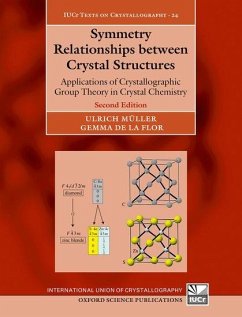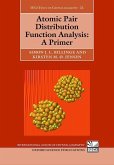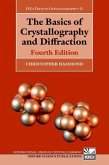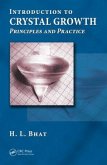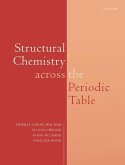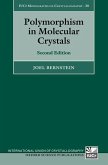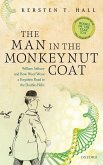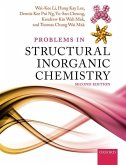Ulrich Muller (Retired Pr Retired Professor of Inorganic Chemistry, Gemma de la Flor (Research Associate, Research Associate, Institut
Symmetry Relationships Between Crystal Structures
Applications of Crystallographic Group Theory in Crystal Chemistry
Ulrich Muller (Retired Pr Retired Professor of Inorganic Chemistry, Gemma de la Flor (Research Associate, Research Associate, Institut
Symmetry Relationships Between Crystal Structures
Applications of Crystallographic Group Theory in Crystal Chemistry
- Gebundenes Buch
- Merkliste
- Auf die Merkliste
- Bewerten Bewerten
- Teilen
- Produkt teilen
- Produkterinnerung
- Produkterinnerung
An essential property of crystalline solids are their symmetries, which are covered by mathematical groups called space groups. This book explains the corresponding mathematical tools and how the space groups can be used to make evident the relationships between crystal structures and to analyse physical phenomena such as structural transitions.
Andere Kunden interessierten sich auch für
![Atomic Pair Distribution Function Analysis Atomic Pair Distribution Function Analysis]() Prof Simon Billinge (Professor of Materials Science and of AppliedAtomic Pair Distribution Function Analysis89,99 €
Prof Simon Billinge (Professor of Materials Science and of AppliedAtomic Pair Distribution Function Analysis89,99 €![The Basics of Crystallography and Diffraction The Basics of Crystallography and Diffraction]() Christopher Hammond (University of Leeds, University of Leeds, InstThe Basics of Crystallography and Diffraction69,99 €
Christopher Hammond (University of Leeds, University of Leeds, InstThe Basics of Crystallography and Diffraction69,99 €![Introduction to Crystal Growth Introduction to Crystal Growth]() H. L. BhatIntroduction to Crystal Growth234,99 €
H. L. BhatIntroduction to Crystal Growth234,99 €![Structural Chemistry Across the Periodic Table Structural Chemistry Across the Periodic Table]() Thomas CW Mak (Emeritus Professor and E Wei Lun Research ProfessorStructural Chemistry Across the Periodic Table89,99 €
Thomas CW Mak (Emeritus Professor and E Wei Lun Research ProfessorStructural Chemistry Across the Periodic Table89,99 €![Polymorphism in Molecular Crystals Polymorphism in Molecular Crystals]() Joel Bernstein (Formerly, Professor of Chemistry, Emeritus, Ben-GurPolymorphism in Molecular Crystals63,99 €
Joel Bernstein (Formerly, Professor of Chemistry, Emeritus, Ben-GurPolymorphism in Molecular Crystals63,99 €![The Man in the Monkeynut Coat The Man in the Monkeynut Coat]() Kersten T. Hall (Visiting Fellow, Visiting Fellow, School of PhilosThe Man in the Monkeynut Coat22,99 €
Kersten T. Hall (Visiting Fellow, Visiting Fellow, School of PhilosThe Man in the Monkeynut Coat22,99 €![Problems in Structural Inorganic Chemistry Problems in Structural Inorganic Chemistry]() Wai-Kee Li (Formerly Emeritus Professo Formerly Emeritus ProfessorProblems in Structural Inorganic Chemistry79,99 €
Wai-Kee Li (Formerly Emeritus Professo Formerly Emeritus ProfessorProblems in Structural Inorganic Chemistry79,99 €-
-
-
An essential property of crystalline solids are their symmetries, which are covered by mathematical groups called space groups. This book explains the corresponding mathematical tools and how the space groups can be used to make evident the relationships between crystal structures and to analyse physical phenomena such as structural transitions.
Produktdetails
- Produktdetails
- International Union of Crystallography Texts on Crystallography
- Verlag: Oxford University Press
- 2 Revised edition
- Seitenzahl: 400
- Erscheinungstermin: 25. Februar 2025
- Englisch
- Abmessung: 251mm x 193mm x 27mm
- Gewicht: 1016g
- ISBN-13: 9780192858320
- ISBN-10: 0192858327
- Artikelnr.: 71183678
- Herstellerkennzeichnung
- Libri GmbH
- Europaallee 1
- 36244 Bad Hersfeld
- gpsr@libri.de
- International Union of Crystallography Texts on Crystallography
- Verlag: Oxford University Press
- 2 Revised edition
- Seitenzahl: 400
- Erscheinungstermin: 25. Februar 2025
- Englisch
- Abmessung: 251mm x 193mm x 27mm
- Gewicht: 1016g
- ISBN-13: 9780192858320
- ISBN-10: 0192858327
- Artikelnr.: 71183678
- Herstellerkennzeichnung
- Libri GmbH
- Europaallee 1
- 36244 Bad Hersfeld
- gpsr@libri.de
Ulrich Mÿller studied chemistry at Technische Hochschule in Stuttgart, Germany from 1959 to 1966 and gained a PhD in Inorganic Chemistry. He worked as a Scientific assistant at Universitÿt Karlsruhe, Germany, with H. Bÿrnighausen from 1967 to 1970 and was a Professor of Inorganic Chemistry at Universitÿt Marburg, Germany, from 1972 to 1992 and 2000 to 2005. He was a Professor of Inorganic Chemistry at Universitÿt Kassel, Germany, from 1992 to 2000, and a visiting Professor at Universidad de Costa Rica, 1975 to 1977. He retired in 2005. Gemma de la Flor studied physics at the University of the Basque Country, Spain from 2004 to 2009 and gained a PhD in Physics at the University of the Basque Country in 2014. She was a post-doc and a lecturer at the University of the Basque Country from 2014 to 2016. She held a post-doc position at Universitÿt Hamburg, Germany, with Professor Boriana Mihailova from 2016 to 2018. Since 2019 she has been a research associate in the petrophysics department at the Karlsruher Institut fÿr Technologie, Germany.
* 1: Introduction
* Part I - Crystallographic Foundations
* 2: Basics of crystallography, part 1
* 3: Mappings
* 4: Basics of crystallography, part 2
* 5: Group theory
* 6: Basics of crystallography, part 3
* 7: Subgroups and supergroups of point and space groups
* 8: Conjugate subgroups and normalizers of space groups
* 9: Equivalent descriptions of crystal structures and chirality
* Part II - Symmetry Relations between Space Groups as a Tool to
Disclose Connections between Crystal Structures
* 10: How to handle space groups
* 11: The group-theoretical presentation of crystal-chemical
relationships
* 12: Symmetry relations between related crystal structures
* 13: Pitfalls when setting up group-subgroup relations
* 14: Derivation of crystal structures from closest packings of spheres
* 15: Crystal structures of molecular compounds
* 16: Symmetry relations at phase transitions
* 17: Topotactic reactions
* 18: Group-subgroup relations as an aid for structure determination
* 19: Prediction of possible structure types
* 20: Historical remarks
* Part III - Widening Excurses to Special Topics
* 21: Isomorphic subgroups
* 22: On the theory of phase transitions
* 23: Symmetry species
* 24: The Bilbao Crystallographic Server
* Appendices
* Part I - Crystallographic Foundations
* 2: Basics of crystallography, part 1
* 3: Mappings
* 4: Basics of crystallography, part 2
* 5: Group theory
* 6: Basics of crystallography, part 3
* 7: Subgroups and supergroups of point and space groups
* 8: Conjugate subgroups and normalizers of space groups
* 9: Equivalent descriptions of crystal structures and chirality
* Part II - Symmetry Relations between Space Groups as a Tool to
Disclose Connections between Crystal Structures
* 10: How to handle space groups
* 11: The group-theoretical presentation of crystal-chemical
relationships
* 12: Symmetry relations between related crystal structures
* 13: Pitfalls when setting up group-subgroup relations
* 14: Derivation of crystal structures from closest packings of spheres
* 15: Crystal structures of molecular compounds
* 16: Symmetry relations at phase transitions
* 17: Topotactic reactions
* 18: Group-subgroup relations as an aid for structure determination
* 19: Prediction of possible structure types
* 20: Historical remarks
* Part III - Widening Excurses to Special Topics
* 21: Isomorphic subgroups
* 22: On the theory of phase transitions
* 23: Symmetry species
* 24: The Bilbao Crystallographic Server
* Appendices
* 1: Introduction
* Part I - Crystallographic Foundations
* 2: Basics of crystallography, part 1
* 3: Mappings
* 4: Basics of crystallography, part 2
* 5: Group theory
* 6: Basics of crystallography, part 3
* 7: Subgroups and supergroups of point and space groups
* 8: Conjugate subgroups and normalizers of space groups
* 9: Equivalent descriptions of crystal structures and chirality
* Part II - Symmetry Relations between Space Groups as a Tool to
Disclose Connections between Crystal Structures
* 10: How to handle space groups
* 11: The group-theoretical presentation of crystal-chemical
relationships
* 12: Symmetry relations between related crystal structures
* 13: Pitfalls when setting up group-subgroup relations
* 14: Derivation of crystal structures from closest packings of spheres
* 15: Crystal structures of molecular compounds
* 16: Symmetry relations at phase transitions
* 17: Topotactic reactions
* 18: Group-subgroup relations as an aid for structure determination
* 19: Prediction of possible structure types
* 20: Historical remarks
* Part III - Widening Excurses to Special Topics
* 21: Isomorphic subgroups
* 22: On the theory of phase transitions
* 23: Symmetry species
* 24: The Bilbao Crystallographic Server
* Appendices
* Part I - Crystallographic Foundations
* 2: Basics of crystallography, part 1
* 3: Mappings
* 4: Basics of crystallography, part 2
* 5: Group theory
* 6: Basics of crystallography, part 3
* 7: Subgroups and supergroups of point and space groups
* 8: Conjugate subgroups and normalizers of space groups
* 9: Equivalent descriptions of crystal structures and chirality
* Part II - Symmetry Relations between Space Groups as a Tool to
Disclose Connections between Crystal Structures
* 10: How to handle space groups
* 11: The group-theoretical presentation of crystal-chemical
relationships
* 12: Symmetry relations between related crystal structures
* 13: Pitfalls when setting up group-subgroup relations
* 14: Derivation of crystal structures from closest packings of spheres
* 15: Crystal structures of molecular compounds
* 16: Symmetry relations at phase transitions
* 17: Topotactic reactions
* 18: Group-subgroup relations as an aid for structure determination
* 19: Prediction of possible structure types
* 20: Historical remarks
* Part III - Widening Excurses to Special Topics
* 21: Isomorphic subgroups
* 22: On the theory of phase transitions
* 23: Symmetry species
* 24: The Bilbao Crystallographic Server
* Appendices

